Preservation News Update
Pantages Theater: Moving ahead for a mid-September re-opening, this
restoration/renovation has covered the entire theater literally and figuratively.
Late June saw the theater encased in giant plastic Cristo-like wrapping as the
exterior is cleaned, stripped, and repainted to original colors and restored
storefronts.
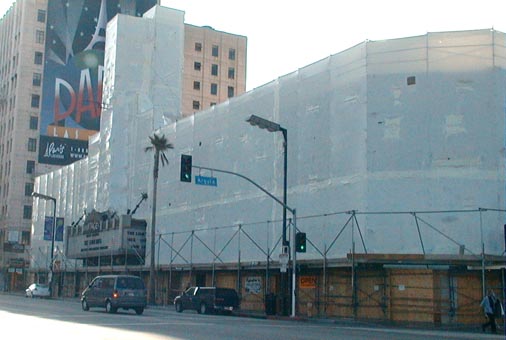 There
has been some controversy around the plan to remove the original Frolic Room
neon sign (from the 1940s), prominently seen in L.A. Confidential among
other movies. Hollywood Heritage opposes such a plan as the Frolic Room is staying
put and any new sign would never match the ’40s style of the original,
which has been faithfully maintained by the owners. The sign’s historic
status is now being reviewed by the Cultural Affairs Department, and such status
is fully supported by Hollywood Heritage.
There
has been some controversy around the plan to remove the original Frolic Room
neon sign (from the 1940s), prominently seen in L.A. Confidential among
other movies. Hollywood Heritage opposes such a plan as the Frolic Room is staying
put and any new sign would never match the ’40s style of the original,
which has been faithfully maintained by the owners. The sign’s historic
status is now being reviewed by the Cultural Affairs Department, and such status
is fully supported by Hollywood Heritage.
Otherwise, the false 1960s bottom of the 1930 marquee was recently removed
to reveal the location of exterior lighting and a wonderful art deco treatment
around the base. All of this is now being restored, to go along with the restoration
of the dramatic exterior entryway and its 400+ lights. Famed theater architect
S. Charles Lee’s statement "The show starts on the sidewalk"
will definitely hold true as Pantages’ architect B. Marcus Priteca’s
designs come back to life after over 40 years of being buried alive.
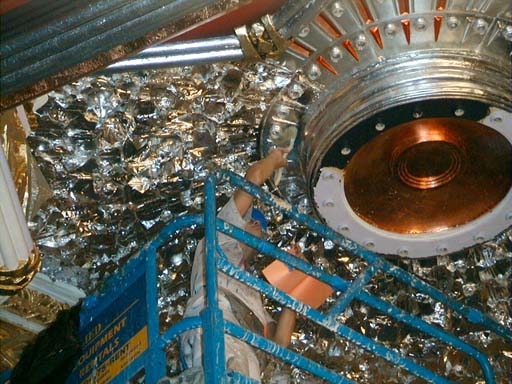 For the interior,
the three massive art deco lobby chandeliers are being rebuilt from the original
plans. They were removed in the mid ’50s to be cleaned, and were never
heard from again. Several murals in the lobby areas have been restored and relit,
as well as those over the proscenium. The theater has a new electrical system
that can handle the demands of any upcoming production as well as the marquee’s
new neon. The 40' x 40' drop stage has been completed along with new dressing
rooms (the stage needs to rise for The Lion King necessitating the relocation
of rooms below it).
For the interior,
the three massive art deco lobby chandeliers are being rebuilt from the original
plans. They were removed in the mid ’50s to be cleaned, and were never
heard from again. Several murals in the lobby areas have been restored and relit,
as well as those over the proscenium. The theater has a new electrical system
that can handle the demands of any upcoming production as well as the marquee’s
new neon. The 40' x 40' drop stage has been completed along with new dressing
rooms (the stage needs to rise for The Lion King necessitating the relocation
of rooms below it).
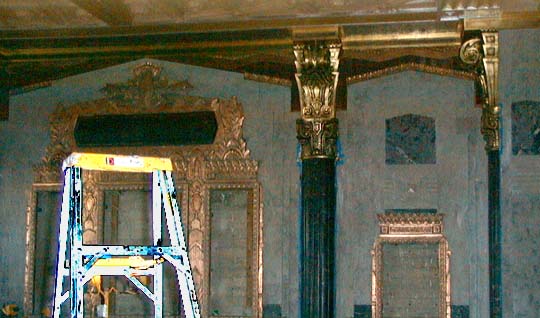 A collection
of projector and special effects equipment found in the projection booth from
the Pantages and the Hollywood Warner (Pacific) Theaters (including items from
the 1928 theater’s Brenograph atmospheric system) were donated to the Hollywood
Heritage Museum by the Nederlander Organization (who own the Pantages and are
footing the $10-$12 million renovation bill). These artifacts are currently
at the museum where some are now on display. Hollywood Heritage thanks Wayne
McWorter and Susan Bredau of the Nederlander Organization for coordinating this
donation and Marc Wannamaker who helped identify and move the several hundred
pounds of equipment that was obtained.
A collection
of projector and special effects equipment found in the projection booth from
the Pantages and the Hollywood Warner (Pacific) Theaters (including items from
the 1928 theater’s Brenograph atmospheric system) were donated to the Hollywood
Heritage Museum by the Nederlander Organization (who own the Pantages and are
footing the $10-$12 million renovation bill). These artifacts are currently
at the museum where some are now on display. Hollywood Heritage thanks Wayne
McWorter and Susan Bredau of the Nederlander Organization for coordinating this
donation and Marc Wannamaker who helped identify and move the several hundred
pounds of equipment that was obtained.
Screen Cartoonists Building: Located at Yucca and Vine streets next
to Capitol Records, this 1931 art deco building by H.L. Gogerty (Baine Building,
Hollywood Playhouse/Palace Theater, etc.) was to have been demolished for a
parking lot. Hollywood Heritage intervened and threatened to file a lawsuit
against the city, the owner of the building, as it was protected under the Hollywood
Redevelopment Plan.
The city backed off and will now restore the building as office space for Capitol
Records. Federal funds obtained to demolish the structure are now being transferred
to be used for its restoration. The first home of the Screen Cartoonists Guild
in 1941, it still has one interior area with its original art deco designs intact.
It is in the capable hands of architect, and Hollywood Heritage board member,
Barry Milofsky, who is also doing the same for the Equitable Building a block
away, completing the triumvirate restoration of three landmark art deco structures
on the north-east block of Hollywood and Vine. Work should start in the late
Fall, for a re-opening on its 70th anniversary as, once again, Hollywood
Heritage has saved a part of the Hollywood entertainment industry, so that it
is not a lost opportunity that ended up in a landfill site.
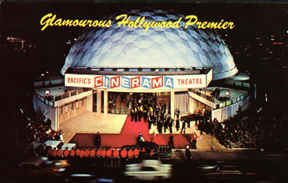 The
Cinerama Dome Theater Development: The Dome will close on July 31 after
a 3-day celebration of 70mm film screenings of Lawrence of Arabia and
Terminator 2, plus screenings of Ben-Hur and archival Cinerama
footage (tickets are only $3.50!). Rehabilitation of the theater will then begin,
along with the construction of 14 new theaters, retail/ restaurant space, a
health club, and a parking structure. The new project would open, hopefully,
by Labor Day 2001.
The
Cinerama Dome Theater Development: The Dome will close on July 31 after
a 3-day celebration of 70mm film screenings of Lawrence of Arabia and
Terminator 2, plus screenings of Ben-Hur and archival Cinerama
footage (tickets are only $3.50!). Rehabilitation of the theater will then begin,
along with the construction of 14 new theaters, retail/ restaurant space, a
health club, and a parking structure. The new project would open, hopefully,
by Labor Day 2001.
Plans are still moving forward to bring 3-projector Cinerama to the theater
for its re-opening. There is also encouraging talk from Pacific Theaters’
Michael Forman that Pacific’s six Cinerama films (This is Cinerama,
Cinerama Holiday, etc.) will be properly protected for the future, including
their use in the 3-projector format (later screenings used an anamorphic print
to show on single projector systems). This is especially important, not just
for showings at the restored Cinerama Dome, but for other theaters in the future
(only Paul Allen’s restored 1963 Seattle Cinerama can currently screen
3-projector Cinerama), and because there have been no new Cinerama prints struck
since 1962 (costs are high as 3 prints are made, plus a separate magnetic soundtrack).
All prints must be done, in essence, by hand so that the colors match on all
three prints, thereby making automated high-speed printing impossible. Thus
the cost of new Cinerama prints is about 8-10 times that of a regular release.
But, it is worth it once you see this still amazing system, as you will be able
to next year thanks to Pacific Theaters and the tenacity of Hollywood Heritage
and Doug Haines’ Friends of the Cinerama.
Chinese Theater: Seismic upgrading, $2 million worth, will begin this
month for the world’s most famous theater. Two more phases of work will
start in the Fall, first with the building’s exterior, then the interior.
 Though
the theater still looks spectacular, it has a way to go to return to its former
architectural glory. Mann Theaters’ new CEO, Barry Reardon, has made the
theater’s restoration a priority, and numerous plans are being developed,
using historic photos and some surviving plans. Many improvements are small
or simply details, but their cumulative impact will bring back the theater’s
full majesty and the importance of Sid Grauman’s beloved palace of cinema.
Though
the theater still looks spectacular, it has a way to go to return to its former
architectural glory. Mann Theaters’ new CEO, Barry Reardon, has made the
theater’s restoration a priority, and numerous plans are being developed,
using historic photos and some surviving plans. Many improvements are small
or simply details, but their cumulative impact will bring back the theater’s
full majesty and the importance of Sid Grauman’s beloved palace of cinema.
One promise is that the original lighting system in the auditorium will be
restored. This created a type of light-show during intermission with almost
1500 hidden ceiling and cove lights, that have not been seen in decades. All
that functions now are about 25 of these lights, so one can only imagine what
this one change alone will do. The light show will also highlight the auditorium’s
detailed architecture, which is now, more or less, in the dark.
Hollywood Heritage thanks Barry Reardon and Mann Theaters for this important
work. Their openness in keeping Hollywood Heritage informed of this project
shows a continuing commitment to our agreement with the TrizecHahn Company,
which is developing the surrounding property, for which the restoration of the
Chinese Theater was a condition of our approval of the project.
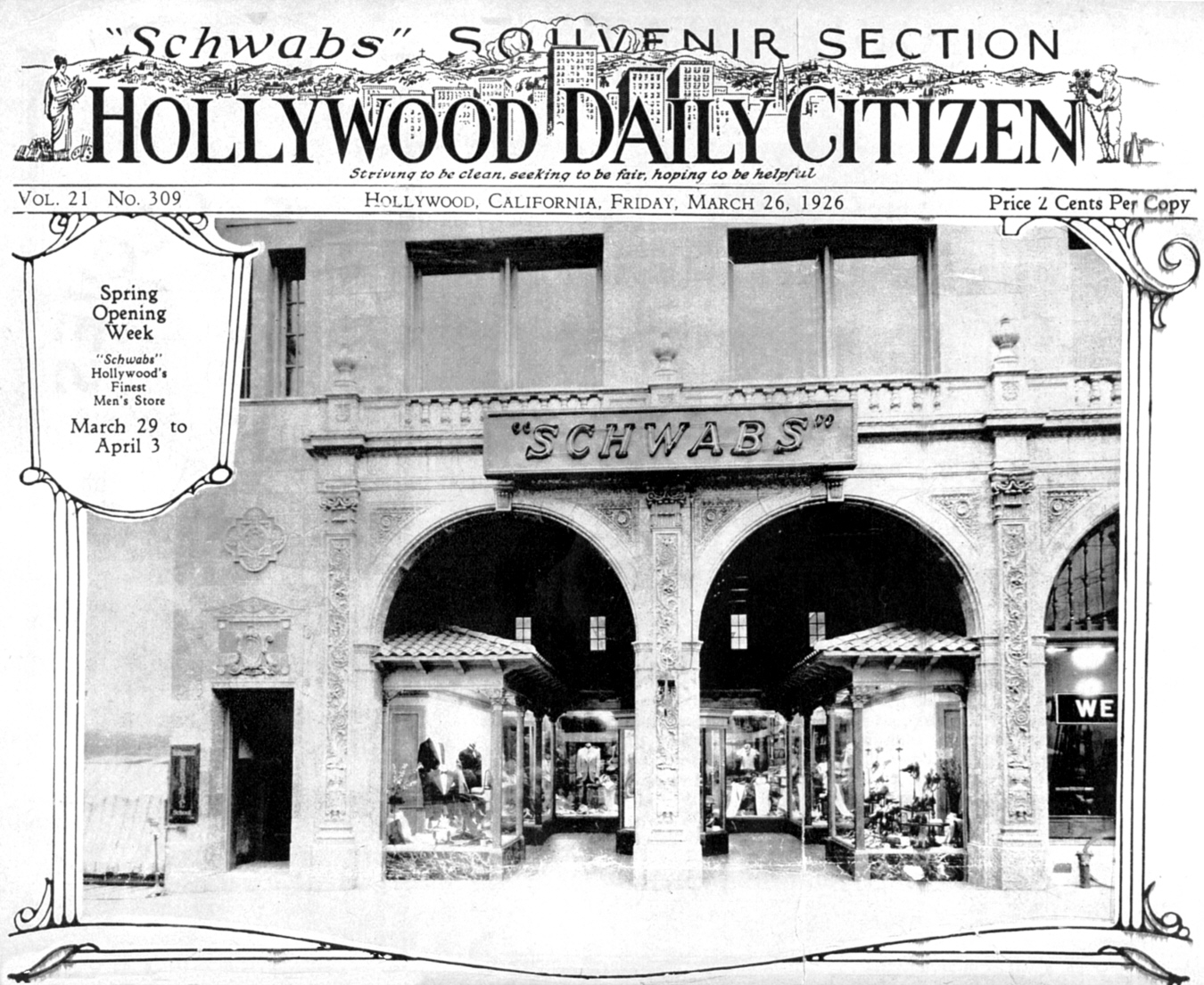 Schwab’s
Men’s Store Building: Recent travelers down Hollywood Boulevard will
have noticed that an old façade has returned at the southwest corner
of Hollywood and Ivar. Covered with stucco since the late 1940s, this 1921 building
was stripped to its original Gladding, McBean & Co. terra cotta façade
by its new owners, Jose Malagon and David Gajda.
Schwab’s
Men’s Store Building: Recent travelers down Hollywood Boulevard will
have noticed that an old façade has returned at the southwest corner
of Hollywood and Ivar. Covered with stucco since the late 1940s, this 1921 building
was stripped to its original Gladding, McBean & Co. terra cotta façade
by its new owners, Jose Malagon and David Gajda.
After many discussions with Hollywood Heritage and the building’s project
manager, Randy Van Ausdall (who has been contracting our work at Wattles Mansion
and the Hollywood Heritage Museum), they agreed to restore the façade
by repairing the existing terra cotta tiles and rebuilding the missing elements
from historic photos (supplied by Hollywood Heritage board member Greg Williams).
This will take about four months, under the direction of Douglas Turner, and
will cost more than was originally budgeted by the new owners, but Mr. Malagon
and Mr. Gajda realized that they had a diamond-in-the-rough and polishing it
would pay off, aesthetically and financially.
The building was known for its 1926 tenant, Schwab’s Men’s Store
that remained there through the 1930s. It was one of the finest men’s haberdasheries
in Los Angeles, and was typical of the type of business that made Hollywood
"the style center of the world," as ads at that time rightly proclaimed.
Schwab’s may be gone, but the wonderful façade will live on thanks
to the efforts of Jose Malagon and David Gajda.
 There
has been some controversy around the plan to remove the original Frolic Room
neon sign (from the 1940s), prominently seen in L.A. Confidential among
other movies. Hollywood Heritage opposes such a plan as the Frolic Room is staying
put and any new sign would never match the ’40s style of the original,
which has been faithfully maintained by the owners. The sign’s historic
status is now being reviewed by the Cultural Affairs Department, and such status
is fully supported by Hollywood Heritage.
There
has been some controversy around the plan to remove the original Frolic Room
neon sign (from the 1940s), prominently seen in L.A. Confidential among
other movies. Hollywood Heritage opposes such a plan as the Frolic Room is staying
put and any new sign would never match the ’40s style of the original,
which has been faithfully maintained by the owners. The sign’s historic
status is now being reviewed by the Cultural Affairs Department, and such status
is fully supported by Hollywood Heritage. For the interior,
the three massive art deco lobby chandeliers are being rebuilt from the original
plans. They were removed in the mid ’50s to be cleaned, and were never
heard from again. Several murals in the lobby areas have been restored and relit,
as well as those over the proscenium. The theater has a new electrical system
that can handle the demands of any upcoming production as well as the marquee’s
new neon. The 40' x 40' drop stage has been completed along with new dressing
rooms (the stage needs to rise for The Lion King necessitating the relocation
of rooms below it).
For the interior,
the three massive art deco lobby chandeliers are being rebuilt from the original
plans. They were removed in the mid ’50s to be cleaned, and were never
heard from again. Several murals in the lobby areas have been restored and relit,
as well as those over the proscenium. The theater has a new electrical system
that can handle the demands of any upcoming production as well as the marquee’s
new neon. The 40' x 40' drop stage has been completed along with new dressing
rooms (the stage needs to rise for The Lion King necessitating the relocation
of rooms below it). A collection
of projector and special effects equipment found in the projection booth from
the Pantages and the Hollywood Warner (Pacific) Theaters (including items from
the 1928 theater’s Brenograph atmospheric system) were donated to the Hollywood
Heritage Museum by the Nederlander Organization (who own the Pantages and are
footing the $10-$12 million renovation bill). These artifacts are currently
at the museum where some are now on display. Hollywood Heritage thanks Wayne
McWorter and Susan Bredau of the Nederlander Organization for coordinating this
donation and Marc Wannamaker who helped identify and move the several hundred
pounds of equipment that was obtained.
A collection
of projector and special effects equipment found in the projection booth from
the Pantages and the Hollywood Warner (Pacific) Theaters (including items from
the 1928 theater’s Brenograph atmospheric system) were donated to the Hollywood
Heritage Museum by the Nederlander Organization (who own the Pantages and are
footing the $10-$12 million renovation bill). These artifacts are currently
at the museum where some are now on display. Hollywood Heritage thanks Wayne
McWorter and Susan Bredau of the Nederlander Organization for coordinating this
donation and Marc Wannamaker who helped identify and move the several hundred
pounds of equipment that was obtained. The
Cinerama Dome Theater Development: The Dome will close on July 31 after
a 3-day celebration of 70mm film screenings of Lawrence of Arabia and
Terminator 2, plus screenings of Ben-Hur and archival Cinerama
footage (tickets are only $3.50!). Rehabilitation of the theater will then begin,
along with the construction of 14 new theaters, retail/ restaurant space, a
health club, and a parking structure. The new project would open, hopefully,
by Labor Day 2001.
The
Cinerama Dome Theater Development: The Dome will close on July 31 after
a 3-day celebration of 70mm film screenings of Lawrence of Arabia and
Terminator 2, plus screenings of Ben-Hur and archival Cinerama
footage (tickets are only $3.50!). Rehabilitation of the theater will then begin,
along with the construction of 14 new theaters, retail/ restaurant space, a
health club, and a parking structure. The new project would open, hopefully,
by Labor Day 2001. Though
the theater still looks spectacular, it has a way to go to return to its former
architectural glory. Mann Theaters’ new CEO, Barry Reardon, has made the
theater’s restoration a priority, and numerous plans are being developed,
using historic photos and some surviving plans. Many improvements are small
or simply details, but their cumulative impact will bring back the theater’s
full majesty and the importance of Sid Grauman’s beloved palace of cinema.
Though
the theater still looks spectacular, it has a way to go to return to its former
architectural glory. Mann Theaters’ new CEO, Barry Reardon, has made the
theater’s restoration a priority, and numerous plans are being developed,
using historic photos and some surviving plans. Many improvements are small
or simply details, but their cumulative impact will bring back the theater’s
full majesty and the importance of Sid Grauman’s beloved palace of cinema. Schwab’s
Men’s Store Building: Recent travelers down Hollywood Boulevard will
have noticed that an old façade has returned at the southwest corner
of Hollywood and Ivar. Covered with stucco since the late 1940s, this 1921 building
was stripped to its original Gladding, McBean & Co. terra cotta façade
by its new owners, Jose Malagon and David Gajda.
Schwab’s
Men’s Store Building: Recent travelers down Hollywood Boulevard will
have noticed that an old façade has returned at the southwest corner
of Hollywood and Ivar. Covered with stucco since the late 1940s, this 1921 building
was stripped to its original Gladding, McBean & Co. terra cotta façade
by its new owners, Jose Malagon and David Gajda.